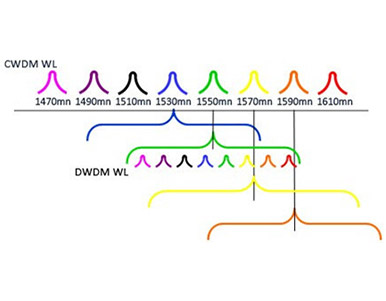Aug. 02, 2018 | 00:00:00
Intensive needs for great bandwidth availability and data transmission capacity have boosted the use of WDM in telecommunication. WDM (wavelength-division multiplexing) is a technology which multiplexes a number of optical carrier signals onto a single optical fiber by using different wavelengths (i.e., colors) of laser light. There are two types of WDM : CWDM and DWDM. This post mainly describes these two types for optical networks.
CWDM Technical Fundamentals
CWDM (conventional/coarse wavelength-division multiplexing) spreads out the light waves instead of trying to keep them closer together, leading to a small increase in the number of channels available through the fiber strands. CWDM technology is mainly used to extend the reach of optical fiber networks in local area BPONs.
DWDM Technical Fundamentals
DWDM (dense wavelength-division multiplexing) enlarges the capacity of a single optical fiber by dividing the optical spectrum into wavelength channels. It tries to keep the channels as close as possible, thus giving rise to a great increase in the number of channels than can pass through the fiber strands. The following image shows CWDM and DWDM ITU channels.

Differences Between CWDM and DMDM
While CWDM shares basics with DWDM, it is useful to understand the differences between them and know that each has its potential utilization while considering several factors. The primary difference between them is the channel numbers. CWDM uses wider wavelength spacing, so fewer channels are supported by it than DWDM. In addition, CWDM is defined by wavelengths, while DWDM is defined in terms of frequencies.
Transmission distances and wavelengths also display differences. CWDM cannot travel long distances because the wavelengths are not amplified. In contrast, DWDM system is intended for longer haul transmission by keeping the wavelengths tightly packed. As for their wavelengths, CWDM system operates on a single-mode fiber with wavelengths ranging from 1270 nm through 1610 nm. By comparison, DWDM system works on a single-mode fiber with wavelengths between approximately 1525 nm and 1565 nm, or from 1570 nm to 1610 nm. Take 120 km DWDM SFP for example, it operates at a nominal DWDM wavelength from 1528.77 nm to 1563.86 nm as specified by the ITU-T. It is designed to deploy in the DWDM networking equipment in metropolitan access and core networks. The following figure shows an overview of a 120 km DWDM SFP transceiver.
s far as modulated laser is concerned, CWDM is based on uncooled distributed-feedback (DFB) lasers and wide-band optical filters, while DWDM deploys cooled distributed-feedback (DFB). This means that DWDM technology needs high-precision filters and lasers which operate at a constant temperature. High-precision, high-stability lasers are expensive, causing a high price of DWDM. In such a case, CWDM has an advantage of attractive price over DWDM.
CWDM and DWDM have made high-performance Ethernet and great storage capacities possible. Based on them, small form-factor pluggable transceiver modules have been designed as convenient and cost-effective solutions for Gigabit Ethernet, such as CWDM SFP transceivers and DWDM SFP transceivers. Fiberstore offers qualified CWDM and DWDM SFPs.